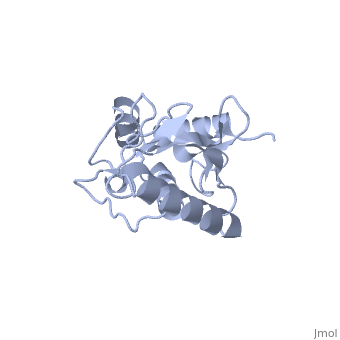Ubc9
From Proteopedia
(Difference between revisions)
| Line 10: | Line 10: | ||
== Function == | == Function == | ||
| - | ''Ubc9'' is a part of the SUMOylation process. It is the enzyme responsible for ligating the SUMO to the protein. Depending on whether the reaction is done ''in vitro'', it will ligate the SUMO directly to the substrate, and if done ''in vivo'', the SUMO will be ligated to the conjugating enzyme and then put onto the substrate [2]. Mutagenesis studies on ''Ubc9'' SUMO1 complex have shown that ''Ubc9H20D'' and ''SUMO1E67R'' mutation cause inhibition of noncovalent interaction between the two, and thus inhibit complex formation <ref name="ubcsumocomplex"/> | + | ''Ubc9'' is a part of the SUMOylation process. It is the enzyme responsible for ligating the SUMO to the protein. Depending on whether the reaction is done ''in vitro'', it will ligate the SUMO directly to the substrate, and if done ''in vivo'', the SUMO will be ligated to the conjugating enzyme and then put onto the substrate [2]. Mutagenesis studies on ''Ubc9'' SUMO1 complex have shown that ''Ubc9H20D'' and ''SUMO1E67R'' mutation cause inhibition of noncovalent interaction between the two, and thus inhibit complex formation. A similar interaction is seen in the ''Ubc9''-SUMO2 complex <ref name="ubcsumocomplex"/>. Lack of noncovalent interaction between ''Ubc9'' and SUMO2 has been shown to inhibit SUMO2 chain formation. This chain formation is critical for ''in vivo'' function, in which formation of ubiquitin or SUMO chains results in cellular processes such as protein degradation <ref name='ubcsumocomplex"/>. |
| - | + | ||
== Disease == | == Disease == | ||
Expression of Ubc9 has been found to be related to causing human diseases such as cancer, neurodegenerative diseases, and heart diseases. Studies have shown it to interact with tumor suppressor proteins such as p53, p63, and p73 and fundamental in the tumor progression and preventing apoptotic pathways. [3] | Expression of Ubc9 has been found to be related to causing human diseases such as cancer, neurodegenerative diseases, and heart diseases. Studies have shown it to interact with tumor suppressor proteins such as p53, p63, and p73 and fundamental in the tumor progression and preventing apoptotic pathways. [3] | ||
| - | + | ||
== Relevance == | == Relevance == | ||
| - | + | ||
== Structural highlights == | == Structural highlights == | ||
| - | - | ||
| - | Anything in this section will appear adjacent to the 3D structure and will be scrollable. | + | ''Anything in this section will appear adjacent to the 3D structure and will be scrollable.'' |
</StructureSection> | </StructureSection> | ||
Revision as of 22:48, 24 February 2015
| |||||||||||
References
- ↑ 1.0 1.1 Tong H, Hateboer G, Perrakis A, Bernards R, Sixma TK. Crystal structure of murine/human Ubc9 provides insight into the variability of the ubiquitin-conjugating system. J Biol Chem. 1997 Aug 22;272(34):21381-7. PMID:9261152
- ↑ 2.0 2.1 Knipscheer P, van Dijk WJ, Olsen JV, Mann M, Sixma TK. Noncovalent interaction between Ubc9 and SUMO promotes SUMO chain formation. EMBO J. 2007 Jun 6;26(11):2797-807. Epub 2007 May 10. PMID:17491593

